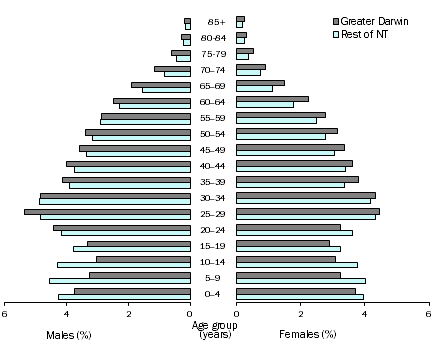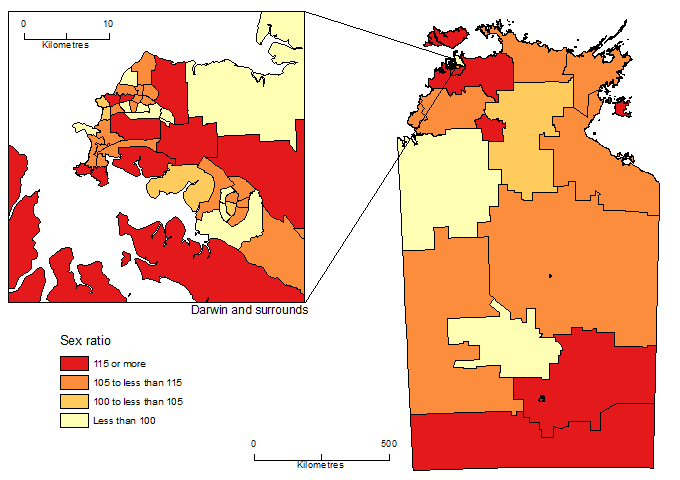NORTHERN TERRITORY
TOTAL POPULATION
The estimated resident population of the Northern Territory (NT) at June 2015 was 244,300 people, an increase of 14,500 (6.3%) since June 2010.
Greater Darwin consists of the SA3s of Darwin City, Darwin Suburbs, Litchfield and Palmerston. These areas were home to over half (58%) of the NT's total population in 2015, increasing by 14,400 people since 2010 to reach 142,300. Over the same five-year period, the rest of the NT increased by 100 people to reach 102,000.
AGE AND SEX DISTRIBUTION
At June 2015, the population of Greater Darwin was generally older than in the rest of the NT. Greater Darwin had a higher proportion of males in all age groups over 20 years with the exception of 30 to 34 year olds which were slightly higher in the rest of the NT. Females aged 25 years and above residing in Greater Darwin were proportionately higher than in the rest of the NT. In contrast, the rest of the NT had a higher proportion of both males and females in the younger age groups, most notably those aged 5 to 14 years.
In Greater Darwin, the 25 to 29 year age group accounted for the largest proportion of the population of any age group, for both males and females. In the rest of the NT, males in the 30 to 34 and females in the 25 to 29 age groups represented the largest proportions.
AGE AND SEX DISTRIBUTION (%), Northern Territory - 30 June 2015

MEDIAN AGE
At June 2015, the NT had a median age (the age at which half the population is older and half is younger) of 32.2 years which was the lowest median age of all states and territories.
The SA2s in the NT with the highest median ages in 2015 were Alligator (41.7 years) followed by Virginia (41.6) and Ross (40.4).
In 2015, Thamarrurr was the SA2 with the lowest median age (23.7 years) followed by Victoria River (25.9) and West Arnhem (26.0).
CHILDREN (UNDER 15 YEARS OF AGE)
At June 2015, there were 53,900 children in the NT, with boys outnumbering girls by 1,400. Although the proportion of children in the NT population declined from 23% in 2010 to 22% in 2015, the NT still had the highest proportion of children of all states and territories in 2015.
In 2015, 20% of Greater Darwin’s population was under 15 years of age. Within Greater Darwin, the SA2s with the highest proportions of children were Lyons (31%) in Darwin's northern suburbs, and Rosebery - Bellamack (30%) and Moulden (28%) in Palmerston.
In the rest of the NT, one quarter of the population was under 15 years of age. The SA2s with the highest proportion of children in the rest of NT were Thamarrurr (36%), Victoria River (33%), and Daly and Nhulunbuy (both 30%).
WORKING AGE POPULATION (AGED 15-64 YEARS)
At June 2015, there were 173,600 people of working age (15 to 64 years) living in the NT, an increase of 8,700 people from June 2010. The NT had the highest proportion of working age population of all states and territories, at 71%.
Within Greater Darwin, the SA2s with the highest proportions of working age population were Darwin City (86%), Larrakeyah, Berrimah and Howard Springs (each 81%).
The SA2 with the highest proportion in the rest of the NT was Petermann - Simpson (79%) in the far south, followed by Alligator in the Top End and Anindilyakwa in East Arnhem Land (both 75%).
WORKING AGE POPULATION (AGED 15-64 YEARS), Statistical Areas Level 2, Northern Territory - 30 June 2015

PEOPLE AGED 65 YEARS AND OVER
At June 2015, there were 16,800 people aged 65 years and over in the NT, representing 6.9% of the total population. While this was an increase from 5.3% in 2010, it was the lowest proportion of all states and territories, with the Australian Capital Territory having the next lowest at 12%.
The SA2 with the highest proportion of population aged 65 years and over in 2015 was the northern suburb of Tiwi in Greater Darwin (14%). This was followed by Ross in Alice Springs (13%) and Fannie Bay - The Gardens (12%) in Greater Darwin. All these SA2s contained retirement villages.
SEX RATIO
There were 129,200 males and 115,100 females in the NT at June 2015. This represents a sex ratio (the number of males per 100 females) of 112.3, an increase from 110.3 in June 2010. The NT had the highest sex ratio of all states and territories in 2015, with more males than females in every five-year age group up to and including 75 to 79 years.
The SA2 of Howard Springs in the Darwin rural area (location of the Darwin Correctional Centre) had the highest sex ratio in the NT, with 188.7 males per 100 females. This was followed by Berrimah (176.8) in the Darwin suburbs, Darwin City (144.0) and Alligator (140.5) in the rest of the NT.
The SA2s with the lowest sex ratios were Palmerston - South (82.4), Tiwi (89.9) in the northern suburbs of Darwin and Driver (91.0) in Palmerston.
MALES PER 100 FEMALES, Statistical Areas Level 2, Northern Territory - 30 June 2015

 Print Page
Print Page
 Print All
Print All
 Quality Declaration
Quality Declaration